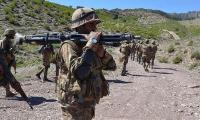India’s Modi and his BJP government continue their aggressive designs against Pakistan. Beginning with sporadic attacks along the Line of Control (LoC) and the Working Boundary (WB), the Modi government moved on to convert these into more regular attacks with an increase in occurrence followed now by a qualitative increase in intensity.
Some would say these continue to be mere pinpricks to divert Pakistan’s attention away from Indian brutality against Kashmiris in Indian Occupied Kashmir (IOK). However, while there may be some truth in this assumption, it is becoming increasingly clear in recent weeks that the Indian military is not simply conducting an Operation Diversion but is in fact conducting a large-scale exploratory exercise designed to test out a new military doctrine. After all, the Cold Start Doctrine went into cold storage after Pakistan developed the Nasr missile.
As the firing along the LoC and WB has increased, Pakistan has responded with return fire but desisted from upping the military ante. Then India chose to intrude into Pakistani waters with its German-made diesel-electric submarine, which has to come up to periscope depth every couple of days. According to media reports, this is what the sub was doing when first detected by the Pakistan Navy. This incident happened just as the CPEC shipping route was inaugurated with the first Chinese shipment being sent from Gwadar. A Pak-China naval exercise was also scheduled to commence a few days later.
Keeping up the military ante, an Indian quad copter was brought down by Pakistan 60 metres inside the Pakistani side of the LoC a day after the submarine incident. On November 22, while IDEAS was being inaugurated in Karachi, India conducted ballistic missile tests as part of a user trial by the Indian army.
What does all this mean? At one level, India seems to have successfully diverted Pakistan’s attention away from the continued killings and abuse of Kashmiris by Indian forces in IOK. On the diplomatic front, Pakistan has unfortunately failed to launch an effective diplomatic offensive to expose Indian atrocities in IOK – notwithstanding a few freebie trips for legislators.
What happened to demands by the UN human rights body and OIC to have observer missions visit IOK? Why has Pakistan not pursued the demand to have UNMOGIP have access to the Indian side of the LoC? Why has Pakistan not sought a meeting of the UN Security Council (UNSC) given that Kashmir remains on the agenda of the UNSC?
At a second level, India is testing Pakistan’s responses to its military actions. Will Pakistan continue to limit its military responses to return of fire and repelling of sea intruder vessel or will it up the ante? So far, Pakistan has made clear it will not go beyond responding in a limited albeit effective manner to these nosebleeds.
What would be the accompanying political and diplomatic responses? So far these have been sporadic by Pakistan – with an intermittent censure of the Indian envoy through summons to the Foreign Office and an occasional statement delivered at the UN General Assembly. Despite the increased Indian military aggression, Pakistan has again not moved the UNSC on this growing threat to regional peace and security.
Nor is it a mere coincidence that India’s aggressive stance against Pakistan has become more overt and intense after the Trump electoral victory and during the visit of the Israeli prime minister to New Delhi, which followed a visit by the British PM who chose to visit India and Bangladesh while omitting Pakistan. The diplomatic pats on the back from the UK and Israel for Modi at a time when his government is on a killing spree in IOK and is firing along the LoC and WB seem to have given the BJP government the diplomatic support it needed. With Trump now the president-elect, the Modi government is certainly emboldened as his statements against Pakistan and how he will rely on India to deal with Pakistan are well known.
Perhaps most significant has been the strategic message that has been sent through the statement of Indian Defence Minister Parrikar, on November 11, when he gave out that India did not have a ‘no first use’ nuclear doctrine. This was merely stating what India had already done when it modified its initial ‘no first use’ claim in 2003 after enunciating its Nuclear Command Authority and expanding the operational parameters for its nuclear doctrine.
According to a government of India press release, titled ‘The Cabinet Committee on Security Reviews operationalization of India’s Nuclear Doctrine’, of January 4, 2003, India would not only use nuclear weapons against a nuclear strike against its own territory but would also use nuclear weapons against a nuclear strike on Indian forces “anywhere”. Also, it would use nuclear weapons even against a chemical or biological attack “against India or Indian forces anywhere” – effectively a First Use principle applicable even against a non-nuclear state.
On August 22, 2006, in a speech at the Carnegie Endowment in Washington, the then Indian air chief declared that India would have to “forget geographical boundaries to protect its interests outside its boundaries”. This development was in line with the post-9/11 US pre-emptive doctrine and the US Nuclear Posture Review, whereby the US began to rationalise the military viability of nuclear weapons, even against certain non-nuclear states that may possess other weapons of mass destruction.
Yet Parrikar’s statement earlier this month is significant because of the timing. It is an assertion of the First Use Doctrine specifically meant for Pakistan. The firing along the LoC and WB, the deliberate intrusion by an Indian submarine into Pakistani waters, the spy drones – all these actions together show a new Indian military strategy in the making within the framework of a nuclear First Use strategic doctrine – all to overcome the checkmating of Cold Start by Pakistan’s Nasr missile.
India’s new strategy is a dangerous adventurism but it has been fuelled by the diplomatic support it has received from Washington and other capitals (with even Japan now signing a civil-nuclear agreement with India) and Pakistan’s inability to show an assertive diplomatic-political response.
So India’s new strategy is to keep giving Pakistan nosebleeds along the LoC and WB, gradually upping the ante through the use of naval power before a final push through a rapid land attack – confronting Pakistan on multiple fronts in rapid succession. Cold Start was focused on a rapid land move but the new strategy encompasses a multiple level rapid attack after a gradual build up – thereby having a built-in element of surprise.
Unfortunately, Pakistan has misread the signals and failed to formulate a holistic strategic response encompassing military and politico-diplomatic options. India is playing a dangerous chicken game with Pakistan but it needs to realise that nuclear antagonists cannot be locked in a zero sum game environment. Their survival is linked together now. Pakistan needs to send this message clearly to both India and its allies by formulating strong, unambiguous policies and responses.
The writer is DG SSII and a PTI MNA. The views expressed
are her own.
Email: callstr@hotmail.com
Economic nationalism remains potent political narrative, influencing both Republican and Democratic platforms
Yes, blockchain, decentralised and distributed ledger technology, is foundational backbone of cryptocurrencies
Blue carbon covers merely 2.0 per cent of ocean surface but absorbs 50 per cent of carbon dioxide
During WWII, Japan’s economy and national morale were plummeted by its doomed alliance with Germany
More than 40 persons, including women and children, were killed in Parachinar
After November 30, it will be impossible for ordinary internet users to access all banned websites, including X







